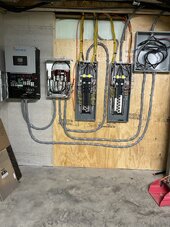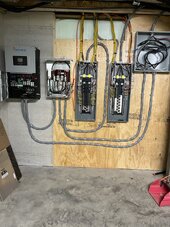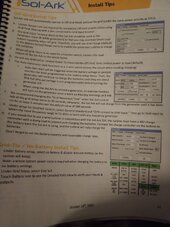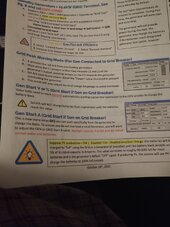You are using an out of date browser. It may not display this or other websites correctly.
You should upgrade or use an alternative browser.
You should upgrade or use an alternative browser.
Sol-ark damaged by small generator?
- Thread starter hautions11
- Start date
hautions11
New Member
hautions11
New Member
Just ordered a CV. Actually back ordered until Mid Jan. No problem for my schedule. The inverter is just a pass through at the moment and batteries are not hooked up. I have 26 panels for the roof, waiting on standing seam mini rails. Before we move in, I really want to run the system for a bit to work out any kinks. I will add a few ground mounts on the south side to get 36 panels for 14kw of PV. Etimate for the all electric house is 18-21 KWH per day. We will be short in the winter. Thanks for all the input.
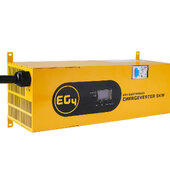

robby
Photon Vampire
- Joined
- May 1, 2021
- Messages
- 4,129
Very true, I had not thought about the kind of generator the OP might be using.I can use a cheap $400 generator to recharge the battery. The CV cleans up the power from the cheap dirty generator. Sol-ark is good if you have a good stand-by auto start generator. If you are going cheap with Plan C, CV is the way to go.
Sol-Arks are pretty tolerant of dirty power, but of course there is a limit.
BTW I had mentioned the EG4 Charger to Sol-Ark a long time ago and they said the only issue to watch for is the power being delivered by the charger and the PV charging should be considered in the equation.
IOW you could overload your batteries if the Sun comes out and the EG4 Charger is running.
Last edited:
RCinFLA
Solar Wizard
- Joined
- Jun 21, 2020
- Messages
- 3,565
Highly doubtful. When grid drops out when inverter is in pass through there is a momentary overload on inverter before it detects overcurrent and releases pass-through relay connection to grid. Unlikely a generator would be worse than a grid drop out.
Worse situation is having an automatic input transfer switch and immediately switching from a live generator feed by auto transfer switch with priority grid feed source immediate switch over when the generator/inverter happens to be 180 degrees out of phase with grid. When automatic transfer switch immediately jumps from generator to grid, the inverter and grid will be 180 degrees out of phase for this situation so effectively you are throwing inverter across 480 vac voltage delta from a grid source capable of high momentary current before AC input circuit breaker pops.
You must always ensure inverter's pass-through relay releases from AC input before applying a different asynchronous AC source input to inverter.
If you use Sol-Ark separate generator input, the Sol-Ark will manage the cross-over from generator to grid gracefully by first opening generator pass-through relay, and resync'g inverter to grid, before closing the grid input pass-through relay.
Worse situation is having an automatic input transfer switch and immediately switching from a live generator feed by auto transfer switch with priority grid feed source immediate switch over when the generator/inverter happens to be 180 degrees out of phase with grid. When automatic transfer switch immediately jumps from generator to grid, the inverter and grid will be 180 degrees out of phase for this situation so effectively you are throwing inverter across 480 vac voltage delta from a grid source capable of high momentary current before AC input circuit breaker pops.
You must always ensure inverter's pass-through relay releases from AC input before applying a different asynchronous AC source input to inverter.
If you use Sol-Ark separate generator input, the Sol-Ark will manage the cross-over from generator to grid gracefully by first opening generator pass-through relay, and resync'g inverter to grid, before closing the grid input pass-through relay.
DIYrich
Solar Wizard
Use the gen limit (basic setup, advanced tab).Hi Rich, I can set the amp limit for charging, but it seems it will still default to pulling loads from the generator as well. That's why I started limiting gen charging time to low loads time.
DIYrich
Solar Wizard
Generator runs out of fuel - frequency and voltage go crazy.Highly doubtful. When grid drops out when inverter is in pass through there is a momentary overload on inverter before it detects overcurrent and releases pass-through relay connection to grid. Unlikely a generator would be worse than a grid drop out.
dougbert
Solar Addict
Very true, I had not thought about the kind of generator the OP might be using.
Sol-Arks are pretty tolerant of dirty power, but of course there is a limit.
BTW I had mentioned the EG4 Charger to Sol-Ark a long time ago and they said the only issue to watch for is the power being delivered by the charger and the PV charging should be considered in the equation.
IOW you could overload your batteries if the Sun comes out and the EG4 Charger is running.
you do NOT need have the chargeverter bulk charge to the same voltage as the solar panels. You are looking to charge the batteries to get you THROUGH the sun shortage and when the sun comes out then the solar panels do the heavy lifting
Panels can charge to 55 v or so on LFP
chargeverter can charge to 53 v. Then the chargeverter will go to FLOAT before the panels do, all safe
On my system with tesla modules, I am setting the chargeverter to float at 43v and just run the house loads until morning sun which will them fully charge the battery. I am adding a programmed AUX contactor to turn ON the grid to the chargeverter at 42 volts and the then turn off grid at 44 volts which indicates the sun is up and the battery is charging. Link to that task
several ways to achieve the goal
robby
Photon Vampire
- Joined
- May 1, 2021
- Messages
- 4,129
Agree but I get what Sol-Ark is saying.you do NOT need have the chargeverter bulk charge to the same voltage as the solar panels. You are looking to charge the batteries to get you THROUGH the sun shortage and when the sun comes out then the solar panels do the heavy lifting
Panels can charge to 55 v or so on LFP
chargeverter can charge to 53 v. Then the chargeverter will go to FLOAT before the panels do, all safe
On a very cloudy day you might run the batteries down and then turn on an external Charger.
If your batteries are down to 51V and the Charger is running at 100A and you forget that the PV is set to 265A and then suddenly a nice opening in the cloud cover occurs you could be sending 365A to the batteries. They are just saying to be mindful that these kinds of events can happen when using an external charger. The solutions is to just back down the Inverters charge setting before hand so that the combined Amperage cannot become a problem. (This is of course assuming the Max amps can exceed your battery banks charge limits.)
On my system with tesla modules, I am setting the chargeverter to float at 43v and just run the house loads until morning sun which will them fully charge the battery. I am adding a programmed AUX contactor to turn ON the grid to the chargeverter at 42 volts and the then turn off grid at 44 volts which indicates the sun is up and the battery is charging. Link to that task
several ways to achieve the goal
Last edited:
hautions11
New Member
Thanks ao much for all the input! I have a much better understanding of the pros and cons. Lets walk through using the gen port in my situation. Getting back to a situation of damaging the inverter The grid is down, batteries are getting low after a couple of days, I fire up the generator to charge the batteries. The Sol-ark will try to pull house loads from the generator. If it exceeds the generators capacity, it could cause problems for the inverter. It appears during a grid down, you could limit the Sol-ark in charging amps and avoid this issue, but slow the recharging of batteries. In my case the two big loads would be geothermal for heat or cool 2100 watts, and hot water heat pump 500 watts. with a 6000 watt generator, I would have to really limit the charging capability, but this scenario seems doable.Agree but I get what Sol-Ark is saying.
On a very cloudy day you might run the batteries down and then turn on an external Charger.
If your batteries are down to 51V and the Charger is running at 100A and you forget that the PV is set to 265A and then suddenly a nice opening in the cloud cover occurs you could be sending 365A to the batteries. They are just saying to be mindful that these kinds of events can happen when using an external charger. The solutions is to just back down the Inverters charge setting before hand so that the combined Amperage cannot become a problem. (This is of course assuming the Max amps can exceed your battery banks charge limits.)
Using the CV, grid down, batteries get low, run the CV/gen at 60-80 amps, top off batteries in 4-6 hours with my current 30 KWH bank. Issues include the sun comes out and throws a big charging load at the batteries. Run the CV at night or early morning would eliminate that issue. Since this is a once every few year scenario, I like both options.
We do lose power a lot. This June, big wind storm, power out 4-5 days. After the storm, fire up the noisy Briggs 4500w generator. Hotter then crap, install a little window AC and plug in the fridges. fill the genny every 9-10 hours. Stop after 2 days, change the oil in the genny. Not too pleasant.
I think the new house will work out a little better. Thanks so much for all your input, there is reading settings in the manual and then listening to experienced operators. Really looking forward to getting the system running in Jan!!!!
robby
Photon Vampire
- Joined
- May 1, 2021
- Messages
- 4,129
I am Grid Tied, so my real world Generator experience is limited.Thanks ao much for all the input! I have a much better understanding of the pros and cons. Lets walk through using the gen port in my situation. Getting back to a situation of damaging the inverter The grid is down, batteries are getting low after a couple of days, I fire up the generator to charge the batteries. The Sol-ark will try to pull house loads from the generator. If it exceeds the generators capacity, it could cause problems for the inverter. It appears during a grid down, you could limit the Sol-ark in charging amps and avoid this issue, but slow the recharging of batteries. In my case the two big loads would be geothermal for heat or cool 2100 watts, and hot water heat pump 500 watts. with a 6000 watt generator, I would have to really limit the charging capability, but this scenario seems doable.
If your off grid the hooking the Generator to the Grid Input on the SA then it would allow for a fairly seamless operation but if your using the Gen Input I can only assume the newer firmware deals with the Generator on the Gen input like it does with the Grid input, that was what I think I heard the plan was with the last 3-4 updates.
If your TOU settings is set for Gen Charging and Gen Charging is limited to Amp equivalent of 3KW and Gen Limit set to 6Kw.
Then the TOU would allow battery power to be pulled from the Bank so long as the TOU SOC% setting requirement is met.
So with the Generator limited to 6Kw and 3Kw is being used to power the Loads and 3KW is being used to charge the batteries then the Sol-Ark if allowed by TOU and the SOC% of the Bank being high enough, it would draw any extra power from the batteries.
Lets say a 5Kw AC is turned on and added to the 3KW the house was using. I assume 6KW would be from the Generator and 2KW from the batteries. As soon as the AC compressor cycles off the batteries would resume the 3KW of charging and generator would be powering the original 3KW load.
The tricky bit is if the batteries dip below the SOC setting. I wonder if the Battery bank shut off SOC would override the TOU setting SOC??
In any case if there is not some manual management of loads going on there is going to be a point when that batteries are not charged enough and then it's just the Generator carrying all the loads. Of course the generator will then trip if you surge past what it can handle.
Using the CV, grid down, batteries get low, run the CV/gen at 60-80 amps, top off batteries in 4-6 hours with my current 30 KWH bank. Issues include the sun comes out and throws a big charging load at the batteries. Run the CV at night or early morning would eliminate that issue. Since this is a once every few year scenario, I like both options.
We do lose power a lot. This June, big wind storm, power out 4-5 days. After the storm, fire up the noisy Briggs 4500w generator. Hotter then crap, install a little window AC and plug in the fridges. fill the genny every 9-10 hours. Stop after 2 days, change the oil in the genny. Not too pleasant.
I think the new house will work out a little better. Thanks so much for all your input, there is reading settings in the manual and then listening to experienced operators. Really looking forward to getting the system running in Jan!!!!
RCinFLA
Solar Wizard
- Joined
- Jun 21, 2020
- Messages
- 3,565
The SolArk's are intended to have load shaving, although I have heard some models don't have it yet, like the 15k model. Units that are missing it are supposed to get it eventually in a firmware update.If it exceeds the generators capacity, it could cause problems for the inverter. It appears during a grid down, you could limit the Sol-ark in charging amps and avoid this issue, but slow the recharging of batteries. In my case the two big loads would be geothermal for heat or cool 2100 watts, and hot water heat pump 500 watts. with a 6000 watt generator, I would have to really limit the charging capability, but this scenario seems doable.
With AC input current limit setup by user, be it on generator ACin port or grid ACin port, which can be set to different ACin current limits, as AC input current limit is approached the first thing that happens is it automatically backs down charging to give priority to AC out loads.
As AC loads approach AC input current limit, charging will drop to zero. If AC out load exceeds AC input limit the inverter should supplement AC input from battery power to keep to AC input current set limit.
The last part of inverter supplementing AC input is the tricky part for a HF inverter and is likely what is holding up some of the firmware updates. The battery to high frequency HV DC converter has to switch from reverse power mode for charging batteries to forward power mode to supply HV DC from battery to create AC output power. This takes a few milliseconds to make the power flow direction mode switchover.
The SolArk's (and DEYE) inverters have a large bank of HV DC capacitors that is used to fill in and supply continuous HV DC supply while the battery to HV DC converter is 'offline' for a few milliseconds making its power flow direction changeover. This gives the appearance that the inverter has instant bi-directional changeover in its power flow in or out of battery, within limits of time/current draw of what the HV DC capacitors can supply before their voltage decays off too much.
This instant battery direction power flow switching ability is also necessary to do AC coupling input from a PV grid tie inverter. When there is not grid available to dump power to, and an AC load is switched off causing excess PV power to deal with, the inverter must instantly be able to push the excess PV power to battery until frequency shifting can back down GT inverter(s) output power which may take a few seconds to accomplish. A few seconds does not sound like much time, but it is enough to damage inverter if the excess PV power is not immediately dealt with.
SolArk also provided a failsafe for GT inverter AC coupling input attachment by redefining the generator input port to use it for GT inverter input. If inverter gets into trouble with excess PV GT power input, it can immediately open gen port pass-through relay disconnecting GT inverter. You lose the generator port for a generator input if you use it for GT inverter(s) input.
Last edited:
hautions11
New Member
Robby, thanks for that detail on set up. I truly do not understand some of the parameters to set and how much influence they have on a variety of things. I am looking forward to playing with some of these items on the set up of my system. My big fear is doing it wrong and hurting the inverter.
robby
Photon Vampire
- Joined
- May 1, 2021
- Messages
- 4,129
Your welcome and remember you have plenty of guys on this forum that can help you.Robby, thanks for that detail on set up. I truly do not understand some of the parameters to set and how much influence they have on a variety of things. I am looking forward to playing with some of these items on the set up of my system. My big fear is doing it wrong and hurting the inverter.
Just keep on reading the manual and the various posts and it will all fall into place very quickly.
Also keep in mind that Sol-Ark support is the best out there. Once you have Internet connected to the Inverter they can log in and adjust the settings to match what you are trying to achieve.
Personally I found it to be a lot more useful to learn the settings via the LCD first and then if I have an issue get some advice from Sol-Ark. Make sure to learn how to do everything necessary from the LCD and then go into Powerview Webportal and get use to doing them from the laptop or phone.
There will almost certainly going to be times when you need to adjust stuff and have no Network connection. It is very important that you know your way around the LCD before you get comfy using the computer to do it.
robby
Photon Vampire
- Joined
- May 1, 2021
- Messages
- 4,129
Really, I thought it was in the 15K.The SolArk's are intended to have load shaving, although I have heard some models don't have it yet, like the 15k model. Units that are missing it are supposed to get it eventually in a firmware update.
With AC input current limit setup by user, be it on generator ACin port or grid ACin port, which can be set to different ACin current limits, as AC input current limit is approached the first thing that happens is it automatically backs down charging to give priority to AC out loads.
As AC loads approach AC input current limit, charging will drop to zero. If AC out load exceeds AC input limit the inverter should supplement AC input from battery power to keep to AC input current set limit.
The last part of inverter supplementing AC input is the tricky part for a HF inverter and is likely what is holding up some of the firmware updates. The battery to high frequency HV DC converter has to switch from reverse power mode for charging batteries to forward power mode to supply HV DC from battery to create AC output power. This takes a few milliseconds to make the power flow direction mode switchover.
The SolArk's (and DEYE) inverters have a large bank of HV DC capacitors that is used to fill in and supply continuous HV DC supply while the battery to HV DC converter is 'offline' for a few milliseconds making its power flow direction changeover. This gives the appearance that the inverter has instant bi-directional changeover in its power flow in or out of battery.
This instant battery direction power flow switching ability is also necessary to do AC coupling input from a PV grid tie inverter. When there is not grid available to dump power to, and an AC load is switched off causing excess PV power to deal with, the inverter must instantly be able to push the excess PV power to battery until frequency shifting can back down GT inverter(s) output power which may take a few seconds to accomplish. A few seconds does not sound like much time, but it is enough to damage inverter if the excess PV power is not immediately dealt with.
SolArk also provided a failsafe for GT inverter AC coupling input attachment by redefining the generator input port to use it for GT inverter input. If inverter gets into trouble with excess PV GT power input, it can immediately open gen port pass-through relay disconnecting GT inverter. You lose the generator port for a generator input if you use it for GT inverter(s) input.
I will ask my friend at Sol-Ark what is happening.
Mine does. I purchased it late May this year, Manual dated Sept,'22Really, I thought it was in the 15K.
I will ask my friend at Sol-Ark what is happening.
Attachments
Last edited:
Similar threads
- Replies
- 1
- Views
- 97



